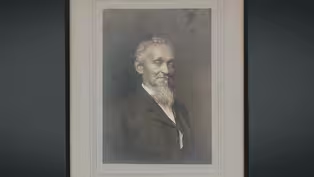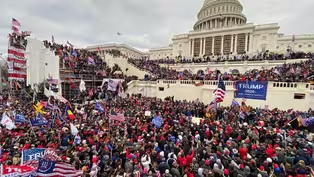
Supreme Court hears challenge to student loan relief plan
Clip: 2/28/2023 | 11m 12sVideo has Closed Captions
Breaking down the arguments as Supreme Court hears challenge to student loan relief plan
The fate of student debt relief promised for some 40 million Americans is in the hands of the Supreme Court. The justices heard arguments in high-stakes cases over the legality of President Biden’s student loan forgiveness plan. John Yang discussed the arguments with NewsHour Supreme Court Analyst Marcia Coyle and Danielle Douglas-Gabriel of The Washington Post.
Problems playing video? | Closed Captioning Feedback
Problems playing video? | Closed Captioning Feedback
Major corporate funding for the PBS News Hour is provided by BDO, BNSF, Consumer Cellular, American Cruise Lines, and Raymond James. Funding for the PBS NewsHour Weekend is provided by...

Supreme Court hears challenge to student loan relief plan
Clip: 2/28/2023 | 11m 12sVideo has Closed Captions
The fate of student debt relief promised for some 40 million Americans is in the hands of the Supreme Court. The justices heard arguments in high-stakes cases over the legality of President Biden’s student loan forgiveness plan. John Yang discussed the arguments with NewsHour Supreme Court Analyst Marcia Coyle and Danielle Douglas-Gabriel of The Washington Post.
Problems playing video? | Closed Captioning Feedback
How to Watch PBS News Hour
PBS News Hour is available to stream on pbs.org and the free PBS App, available on iPhone, Apple TV, Android TV, Android smartphones, Amazon Fire TV, Amazon Fire Tablet, Roku, Samsung Smart TV, and Vizio.
Providing Support for PBS.org
Learn Moreabout PBS online sponsorshipGEOFF BENNETT: Welcome to the "NewsHour."
The fate of some 40 million Americans promised student debt relief is in the hands of the Supreme Court.
AMNA NAWAZ: The justices heard arguments today in high-stakes cases over the legality of President Biden's student loan forgiveness plan.
Students, teachers, and activists gathered outside the court highlighting their struggles and demanding debt relief.
JASMINE JONES-HOWARD, College Student: In order to become those next generation of health care workers, the next generation of working in corporate America, basically being in your law enforcement, in order to do that, we must go to school.
So, how can we give back to our community if we don't have the resources?
DANIELA MRABTI, Digital Director, Alliance For Youth Action: I have upwards of $80,000 of student debt.
Some of that is public.
Some of that is private.
And I think that student debt cancellation would be a benefit for many, many people, millions.
AMNA NAWAZ: The issue has been embroiled in the courts since the president announced his debt relief plan in August of last year.
GEOFF BENNETT: John Yang has more on the days argument.
arguments.
JOHN YANG: The court heard two challenges to the president's plan, one from six Republican-led states and another from two student loan borrowers, one who doesn't qualify for the relief because her loans are held by private lenders, and one who doesn't qualify for the program's maximum benefit.
To discuss the arguments, "NewsHour" Supreme Court analyst Marcia Coyle.
And to talk about what's at stake, Danielle Douglas-Gabriel, a Washington Post national education reporter.
Marcia, there seemed to be a lot of skepticism today about this Biden plan.
MARCIA COYLE: Right, John.
The skepticism seemed to be among primarily the court's conservative wing.
And it is always hard to predict, but my sense after the questioning was that there may be five conservative justices who, looking at the merits of the case, would not uphold the student loan forgiveness program.
But standing in their way of getting to the merits of that program is a big hurdle.
And that is called standing.
Justice Barrett, along with the court's liberal wing, was very focused on standing, which we have talked about before.
It is the legal right to actually sue and hear.
The challengers have to show that they have a specialized injury, a concrete injury that is traceable to the conduct of the Education Department policy, and that the court can remedy it.
It is a huge hurdle, and my sense after the arguments was also that the lawyers for the challengers were not making really as strong an argument as the government made to oppose standing.
If the court doesn't find standing, the case goes away, and the program stands.
But, if they do, they can go on to the merits.
And I also know that, if you have five justices who really want to get to the merits, they may likely find standing some way.
JOHN YANG: One reason the conservative justices were so skeptical about the constitutionality of the Biden plan is that they say there is no specific legislation authorizing it.
Here is Chief Justice John Roberts questioning the Biden administration's attorney.
JOHN ROBERTS, Chief Justice of the U.S. Supreme Court: The case reminds me of the one we had a few years ago under a different administration where the administration tried, acting on its own, to cancel the dreamers program, and we blocked that effort.
And I just wonder, given the posture of the case and given our historic concern about the separation of powers, that you would recognize at least that this is a case that presents extraordinarily serious, important issues about the role of Congress and about the role that we should exercise in scrutinizing that?
JOHN YANG: Marcia, this idea that Congress should be the one to decide big issues, that is sort of a theme for this conservative majority, isn't it?
MARCIA COYLE: It is, and a recent one.
It has to do with something called the major questions doctrine.
The court said in June in a case involving the Clean Air Act and EPA that if an agency issues a policy that has serious major political and economic consequences, then the express authorization of Congress is required.
And that's the primary argument of the challengers in this case, that this is a major questions doctrine case, and the court should apply that to require Congress to expressly authorize what the Department of Education did here.
JOHN YANG: The liberal justices take a different view of the question of who should decide.
MARCIA COYLE: Yes.
JOHN YANG: This is Justice Sonia Sotomayor questioning the Nebraska solicitor general.
SONIA SOTOMAYOR, U.S. Supreme Court Associate Justice: There's 50 million students who are -- will benefit from this who today will struggle.
Many of them don't have assets sufficient to bail them out after the pandemic.
And what you're saying is, now we're going to give judges the right to decide how much aid to give them, instead of the person with the expertise and the experience, the secretary of education, who has been dealing with educational issues and the problems surrounding student loans.
JOHN YANG: The three liberal justices, Sotomayor, Kagan and Jackson, seemed very sympathetic to the Biden administrator argument that this was authorized by Congress.
MARCIA COYLE: Absolutely.
Justice Kagan said that the act that the department used to promulgate this program is very clear.
In fact, she said it couldn't be any clearer that Congress gave the secretary the authority to waive or modify student loan requirements.
And she said the court often gets statutes that aren't very clear.
But, this one, she said is -- Congress has made clear its intent here.
JOHN YANG: Well, there was a lot of discussion about those two words, waive and modify.
MARCIA COYLE: That's right.
That's another issue in the case.
Justice Thomas was saying, well, waive and modify, how does that amount to cancellation, as can happen in some of the student loans that have -- that are being looked at here?
And the government argues that it's waived and modified the requirements around student loans, and the secretary did both here.
And then once he waived and modified them, he created -- he imposed new ones, the ones that are being challenged today.
JOHN YANG: And the conservative justices also talked about fairness.
MARCIA COYLE: Yes, that's -- that was a very interesting exchange.
Some of the justices, the chief justice, Justice Alito, Justice Kavanaugh, they spoke about, how, well, you know -- I think it was the chief justice gave the best sort of hypothetical.
He talked about two students who graduate from high school.
One takes out a loan to go to college.
Another takes out a loan to create a lawn service.
Why should the student who goes to college and will probably make more than the lawn service student in a lifetime, why should that student have a debt forgiven, but not the lawn service?
And the government said very clearly that this act involves student loans.
It doesn't involve other types of loans.
And there are other types of aid available to the lawn service student who has that loan.
So, there is that concern.
And they were asking whether they should factor into their analysis the idea of fairness here.
JOHN YANG: Danielle Douglas-Gabriel, if this program were to go away, what kind of student would -- or student loan borrower would be most heavily affected?
DANIELLE DOUGLAS-GABRIEL, The Washington Post: Well, because student loan debt is disproportionately shouldered by Black borrowers and borrowers of color, they would be the ones who would most likely be impacted.
I think it's really telling that the administration's chose to add, essentially, a Pell Grant bonus allowing for borrowers who had federal Pell Grants for low-income students to receive an additional $10,000.
And many people would qualify for that, because many of those who are -- have gone to college in the last few decades have fewer resources than in generations pass.
JOHN YANG: Without this program, when will the crunch come for these borrowers?
DANIELLE DOUGLAS-GABRIEL: Well, the Department of Education has said that payments will start to resume 60 days after a decision is made, and it's certainly no later than June of this year.
Now, keep in mind that borrowers have not made payments, most borrowers, federal student loan borrowers, have not made payments on their loans for nearly three years at this stage.
And there is a lot of concern, in part -- and this is the reason why the administration says this policy is needed - - that many of those borrowers will struggle to make payments on their loans, they will become delinquent, or potentially default on their loans.
JOHN YANG: In January, the administration unveiled a new income-based student repayment plan.
How does that work?
DANIELLE DOUGLAS-GABRIEL: Well, this plan pretty much updates an existing student loan repayment plan by assuring that borrowers pay less of their discretionary income for a shorter amount of time before getting their student loans forgiven.
So, for example, an undergraduate borrow who's taken out $12,000 or less in undergraduate debt could pay 5 percent of their discretionary income for 10 years before the balance of their loans are forgiven.
JOHN YANG: What are the options for the administration if this plan gets struck down?
DANIELLE DOUGLAS-GABRIEL: So, the administration could try to make this happen through an authority under the Higher Education Act.
Now, that would require a negotiated rulemaking, which is a pretty lengthy process.
And I think that came up today during the arguments.
And one of the reasons why it really wasn't the most salient route for the administration is because it really undermines the idea that this is for an emergency, for a national emergency, and this is to prevent any kind of fallout from that national emergency.
The HEA doesn't exactly lend itself to that argument, whereas, at least in the administration's views, the HEROES Act does.
JOHN YANG: Is the Education Department, is the administration already thinking about these things?
DANIELLE DOUGLAS-GABRIEL: Well, they're not telling me.
I have been asking a whole lot the last few days.
And they keep saying that they're very confident that the HEROES Act gives them the authority that is needed to make sure that this program will go forward.
And they are confident that the Supreme Court will agree.
Certainly, after today's arguments, lots of folks who are watching this don't necessarily take that optimistic a view.
But, at this moment, there isn't a concrete plan that's being publicly discussed about what will happen next if the plan is struck down by the court.
JOHN YANG: Danielle Douglas-Gabriel of The Washington Post, Marcia Coyle, "NewsHour" Supreme Court analyst, thank you both very much.
MARCIA COYLE: Pleasure, John.
DANIELLE DOUGLAS-GABRIEL: Thank you.
Exhibit spotlights portraits, stories of Black Southerners
Video has Closed Captions
Clip: 2/28/2023 | 5m 9s | Exhibit spotlights portraits and stories of Black Southerners living during Jim Crow era (5m 9s)
Food banks prepare for spike as pandemic SNAP benefits end
Video has Closed Captions
Clip: 2/28/2023 | 7m 11s | Food banks prepare for spike as pandemic SNAP benefits come to an end (7m 11s)
Jan. 6 investigator says giving footage to Fox poses threat
Video has Closed Captions
Clip: 2/28/2023 | 8m 26s | Former Jan. 6 investigator says releasing footage to Fox could pose a new threat (8m 26s)
Ukrainians in Bucha reflect on horrors and Russian brutality
Video has Closed Captions
Clip: 2/28/2023 | 9m 20s | Ukrainians in Bucha reflect on horrors and brutality suffered at hands of Russian forces (9m 20s)
Providing Support for PBS.org
Learn Moreabout PBS online sponsorship
- News and Public Affairs

FRONTLINE is investigative journalism that questions, explains and changes our world.

- News and Public Affairs

Amanpour and Company features conversations with leaders and decision makers.












Support for PBS provided by:
Major corporate funding for the PBS News Hour is provided by BDO, BNSF, Consumer Cellular, American Cruise Lines, and Raymond James. Funding for the PBS NewsHour Weekend is provided by...



